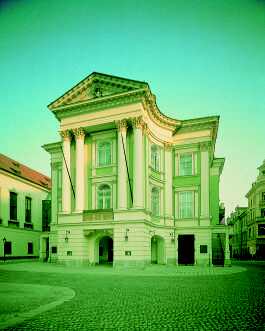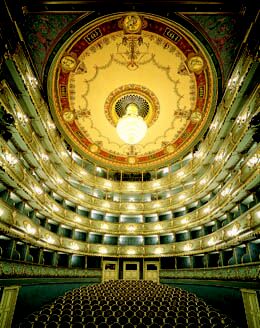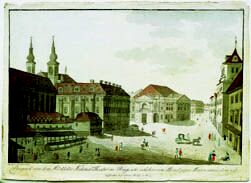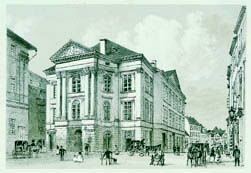Mozart's Estates Theatre
Also called Nostitz Theatre or Tyl Theatre. One of the most beautiful historic theatre buildings in Europe built by the Count Nostitz Rieneck in 1783. W. A. Mozart himself conducted the world premiere of his don Giovanni here in 1787. One of the stages of the Prague National Theatre
| address | Ovocnďż˝ trh 1, Praha 1, 110 00, Czech Republic |
| www, email | http://www.estatestheatre.cz, tickets@czechopera.cz |
The Theatre where Amadeus Mozart himself conducted the world premiere of his Don Giovanni in 1787
 The Theatre of the Estates is one of the most beautiful historic theatre buildings in Europe. The aristocrat František Antonín Count Nostitz Rieneck, fired by a desire to enhance the charm of his native city and the minds of his fellow citizens, had this edifice built. It took not quite two years to construct and the theatre was officially opened in 1783 with a first performance of the tragedy Emilia Galotti by Lessing. Originally the theatre was dubbed Count Nostitz’s Theatre. This exceptional project for Prague of the time corresponded to the prevailing spirit at the end of 18th century when national theatres were being built at European courts, in towns and cultural centres in keeping with the visions of enlightenment promoted by facilitating general access to theatres, considered to be moral institutions demonstrating the cultural standard of a nation. The inscription above the portal reads Patriae et Musis - To the Native Land and the Muses. This motto serves as a proof of the founder’s original intention and has lost none of its validity to this day. When this theatre was linked to the National Theatre, the latter’s motto “The Nation Unto Itself” became a natural complement to the former.
The Theatre of the Estates is one of the most beautiful historic theatre buildings in Europe. The aristocrat František Antonín Count Nostitz Rieneck, fired by a desire to enhance the charm of his native city and the minds of his fellow citizens, had this edifice built. It took not quite two years to construct and the theatre was officially opened in 1783 with a first performance of the tragedy Emilia Galotti by Lessing. Originally the theatre was dubbed Count Nostitz’s Theatre. This exceptional project for Prague of the time corresponded to the prevailing spirit at the end of 18th century when national theatres were being built at European courts, in towns and cultural centres in keeping with the visions of enlightenment promoted by facilitating general access to theatres, considered to be moral institutions demonstrating the cultural standard of a nation. The inscription above the portal reads Patriae et Musis - To the Native Land and the Muses. This motto serves as a proof of the founder’s original intention and has lost none of its validity to this day. When this theatre was linked to the National Theatre, the latter’s motto “The Nation Unto Itself” became a natural complement to the former.
 The site chosen for the building of the Theatre of the Estates was a traditional place for theatre productions adjacent to Kotců and also to Charles University, for the university and theatre were perceived as one. The building is constructed in the classicist style and apart from the theatre in Leoven Styria it is the only theatre of its kind in Europe which has been preserved in its almost original state to this day. In 1798 the theatre was bought by the Czech Estates and as from then it was named the Royal Theatre of the Estates. As of 1862 when the Provisional Theatre was inaugurated as an explicitly and exclusively Czech stage, the Theatre of the Estates was dedicated to a German ensemble only and its name was changed to the Royal Provincial German Theatre. As from 1920 (with the exception of the years of the occupation during World War II) until 1948 the theatre was again called Theatre of the Estates and became an appendage of the National Theatre, especially for the drama company. In 1948 the theatre was renamed the Tyl Theatre and finally, after eight-year long reconstruction work it regained its historic name Theatre of the Estates in 1990.
The site chosen for the building of the Theatre of the Estates was a traditional place for theatre productions adjacent to Kotců and also to Charles University, for the university and theatre were perceived as one. The building is constructed in the classicist style and apart from the theatre in Leoven Styria it is the only theatre of its kind in Europe which has been preserved in its almost original state to this day. In 1798 the theatre was bought by the Czech Estates and as from then it was named the Royal Theatre of the Estates. As of 1862 when the Provisional Theatre was inaugurated as an explicitly and exclusively Czech stage, the Theatre of the Estates was dedicated to a German ensemble only and its name was changed to the Royal Provincial German Theatre. As from 1920 (with the exception of the years of the occupation during World War II) until 1948 the theatre was again called Theatre of the Estates and became an appendage of the National Theatre, especially for the drama company. In 1948 the theatre was renamed the Tyl Theatre and finally, after eight-year long reconstruction work it regained its historic name Theatre of the Estates in 1990.
 The founder Nostitz was a German born in Prague, an enthusiastic local patriot proud of the past Czech kingdom. He built the theatre with the intention of cultivating German dramas and Italian operas. Basically, however, he did not avoid productions in other languages. Productions in German were staged in the Theatre of the Estates until 1920, when the theatre was appropriated by Czechs and annexed to the National Theatre. In addition to German productions the Theatre of the Estates also presented plays in Czech soon after it was opened and this building is also associated with the beginnings of Czech professional drama. The first Czech performances were presented in 1785 randomly and sporadically (essentially for commercial reasons to increase proceeds by attracting the broad masses of the Czech public); as of 1812 this became a regular feature of Sundays and holiday matinees. In those days these performances were to a certain extent a matter of politics. This gave rise, following the difficult years after the defeat of the revolution of 1848 and the forced departure of J.K. Tyl, to the idea of establishing a National Theatre.
The founder Nostitz was a German born in Prague, an enthusiastic local patriot proud of the past Czech kingdom. He built the theatre with the intention of cultivating German dramas and Italian operas. Basically, however, he did not avoid productions in other languages. Productions in German were staged in the Theatre of the Estates until 1920, when the theatre was appropriated by Czechs and annexed to the National Theatre. In addition to German productions the Theatre of the Estates also presented plays in Czech soon after it was opened and this building is also associated with the beginnings of Czech professional drama. The first Czech performances were presented in 1785 randomly and sporadically (essentially for commercial reasons to increase proceeds by attracting the broad masses of the Czech public); as of 1812 this became a regular feature of Sundays and holiday matinees. In those days these performances were to a certain extent a matter of politics. This gave rise, following the difficult years after the defeat of the revolution of 1848 and the forced departure of J.K. Tyl, to the idea of establishing a National Theatre.
 There was a number of founding generations of Czech dramatists who were active on the stage of the Theatre of the Estates. Beginning with the pioneers the brothers Thám, J. N. Štěpánek through to Klicpera, J. K. Tyl, J. J. Kolár and many more. For instance K. H. Mácha appeared on this stage, the first Czech modern opera - Škroup’s The Tinker was presented here in 1826, it was here in 1834 that the song “Where Is My Home” (later to become the Czech National Anthem) was rendered for the first time. The Theatre of the Estate is permanently linked with the name of Wolfgang Amadeus Mozart. It was here that apart from other works that the world premieres of two of his operas were staged: the famous Don Giovanni on October 29, 1787 – which Mozart himself conducted) and the opera La Clemenza di Tito (1791, to mark the coronation of Leopold II). In the course of its history the Theatre of the Estates attracted some significant artists of European stature: Carl Maria von Weber was a conductor here, Angelica Catalani sang here, Nicolo Paganini gave concerts, there were conductors Rubinstein, Carl Goldmark, Gustav Mahler, the famous actors included W.A. Iffland, F. Raimund, J.N. Nestroy, Wenzl Scholze, the negro tragedian Ira Aldridge, the French tragedienne Rachel and many more.
There was a number of founding generations of Czech dramatists who were active on the stage of the Theatre of the Estates. Beginning with the pioneers the brothers Thám, J. N. Štěpánek through to Klicpera, J. K. Tyl, J. J. Kolár and many more. For instance K. H. Mácha appeared on this stage, the first Czech modern opera - Škroup’s The Tinker was presented here in 1826, it was here in 1834 that the song “Where Is My Home” (later to become the Czech National Anthem) was rendered for the first time. The Theatre of the Estate is permanently linked with the name of Wolfgang Amadeus Mozart. It was here that apart from other works that the world premieres of two of his operas were staged: the famous Don Giovanni on October 29, 1787 – which Mozart himself conducted) and the opera La Clemenza di Tito (1791, to mark the coronation of Leopold II). In the course of its history the Theatre of the Estates attracted some significant artists of European stature: Carl Maria von Weber was a conductor here, Angelica Catalani sang here, Nicolo Paganini gave concerts, there were conductors Rubinstein, Carl Goldmark, Gustav Mahler, the famous actors included W.A. Iffland, F. Raimund, J.N. Nestroy, Wenzl Scholze, the negro tragedian Ira Aldridge, the French tragedienne Rachel and many more.
Following the fusing of the Theatre of the Estates with the National Theatre in 1920 drama became the dominant feature on the stage of the Theatre of the Estates, notably at first with a light-weight conversational repertoire, which gradually became more serious. Significant first performances included Karel Čapek’s White Plague and Mother. A no less important era for the Czech theatre occurred at the turn of the fifties and in the sixties when some of the most prominent Czech producers played an active role – above all Alfred Radok and Otomar Krejča – and when original Czech plays by authors František Hrubín, Milan Kundera and Josef Topol were presented. The opera company concentrated above all on the performances of Mozart operas. The reorganization of the National Theatre company now newly featured the staging of ballets in the Theatre of the Estates.
